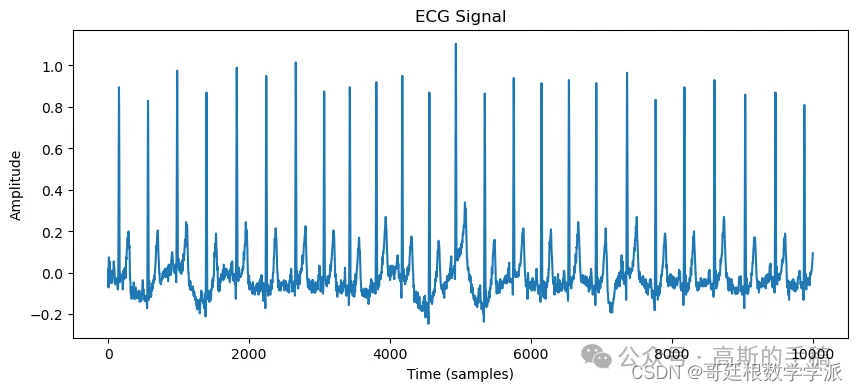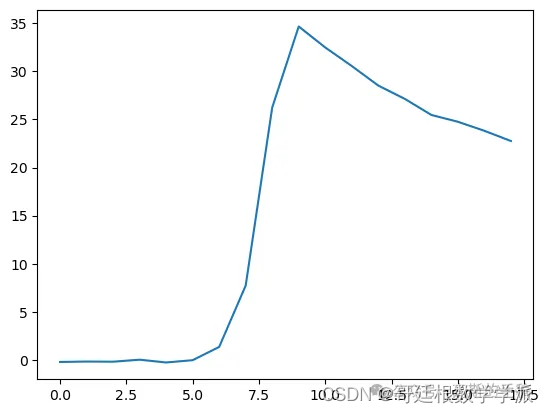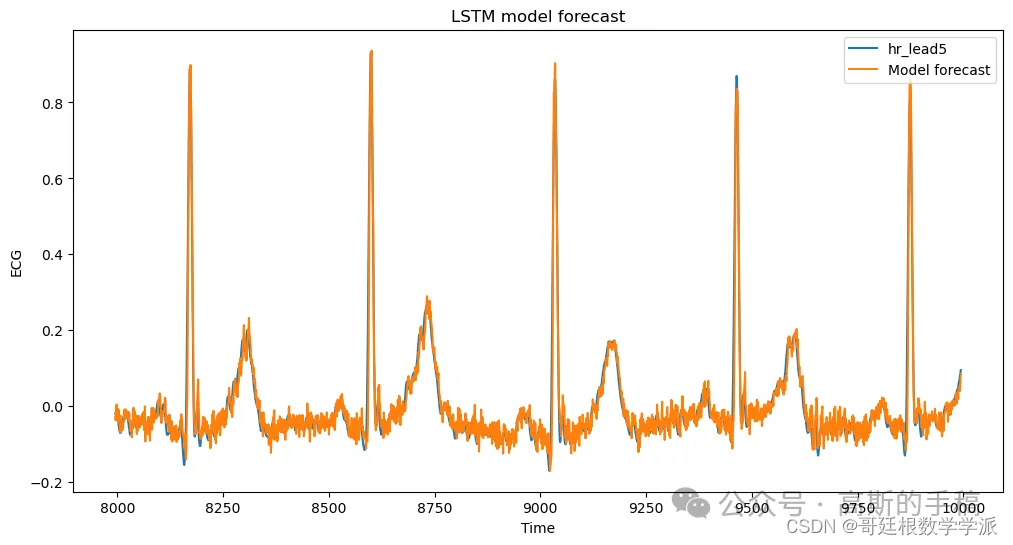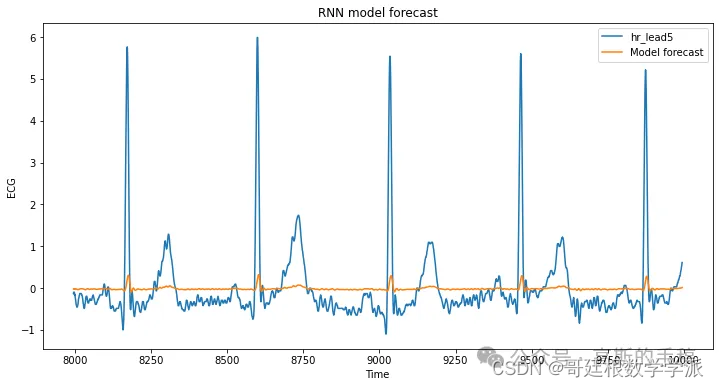所用模块版本:
matplotlib==3.7.1
numpy==1.24.4
pandas==1.5.3
scikit_learn==1.2.2
scipy==1.10.1
seaborn==0.12.2
statsmodels==0.14.0
torch==1.13.1
torch==2.0.1
wfdb==4.1.2主代码:
import itertools
import pandas as pd
import matplotlib.pyplot as plt
#完整代码:mbd.pub/o/bread/mbd-ZpWUmZ1x
import wfdb
import matplotlib.pyplot as plt
# Specify the path to your downloaded data
path_to_data = 'file_resource/ecg-id-database-1.0.0/Person_03/'
# The record name is the filename without the extension
record_name = 'rec_1'
# Use the 'rdrecord' function to read the ECG data
record = wfdb.rdrecord(f'{path_to_data}/{record_name}')
# Plot the ECG data
plt.figure(figsize=(10, 4))
plt.plot(record.p_signal[:,1])
plt.title('ECG Signal')
plt.xlabel('Time (samples)')
plt.ylabel('Amplitude')
plt.show()
pd.DataFrame(record.p_signal[:,1],columns=["hr"]).to_csv("./P3_rec_1.csv")
hr2 = pd.DataFrame(record.p_signal[:,1],columns=["hr"])[0:10000]
# hr2["index"] = hr2.index
plt.figure(figsize=(10, 4))
from torch import nn
import pandas as pd
import numpy as np
import torch
device = torch.device("cuda" if torch.cuda.is_available() else "cpu")
df = hr2.copy()
df_train = df.loc[:8000].copy()
df_test = df.loc[8000:10000].copy()
target_sensor = "hr"
# features = list(df.columns.difference([target_sensor]))
features = ["hr"]
batch_size =32
forecast_lead = 5
forcast_step = 1
target = f"{target_sensor}_lead{forecast_lead}"
df[target] = df[target_sensor].shift(-forecast_lead)
df = df.iloc[:-forecast_lead]
df_train = df.loc[:8000].copy()
df_test = df.loc[8000-forecast_lead:].copy()
print("Test set fraction:", len(df_train) / len(df_test))
target_mean = df_train[target].mean()
target_stdev = df_train[target].std()
for c in df_train.columns:
mean = df_train[c].mean()
stdev = df_train[c].std()
df_train[c] = (df_train[c] - mean) / stdev
df_test[c] = (df_test[c] - mean) / stdev
import torch
from torch.utils.data import Dataset
# parse the data into sliding windows
class SequenceDataset(Dataset):
def __init__(self, dataframe, target, features,sequence_head=10, sequence_length=5):
self.features = features
self.target = target
self.sequence_head = sequence_head
self.sequence_length = sequence_length
self.y = torch.tensor(dataframe[target].values).float()
self.X = torch.tensor(dataframe[features].values).float()
def __len__(self):
return self.X.shape[0]-self.sequence_length +1
def __getitem__(self, i):
if i >= self.sequence_head - 1:
i_start = i - self.sequence_head + 1
x = self.X[i_start:(i + 1), :]
else:
padding = self.X[0].repeat(self.sequence_head - i - 1, 1)
x = self.X[0:(i + 1), :]
x = torch.cat((padding, x), 0)
return x.to(device), self.y[i:i+self.sequence_length].to(device)
train_dataset = SequenceDataset(
df_train,
target=target,
features=features,
sequence_head=forecast_lead,
sequence_length=forcast_step,
)
from torch.utils.data import DataLoader
torch.manual_seed(99)
train_loader = DataLoader(train_dataset, batch_size=batch_size, shuffle=False)
for i, (X, y) in enumerate(train_loader):
# print(X)
# print(y)
# print()
if i >3:break
from torch.utils.data import DataLoader
torch.manual_seed(99)
torch.manual_seed(101)
# define the dataset
train_dataset = SequenceDataset(
df_train,
target=target,
features=features,
sequence_head=forecast_lead,
sequence_length=forcast_step,
)
test_dataset = SequenceDataset(
df_test,
target=target,
features=["hr"],
sequence_head=forecast_lead,
sequence_length=forcast_step,
)
train_loader = DataLoader(train_dataset, batch_size=batch_size, shuffle=True)
test_loader = DataLoader(test_dataset, batch_size=1, shuffle=False)
X, y = next(iter(train_loader))
print("Features shape:", X.shape)
print("Target shape:", y.shape)
from torch import nn
# define the model
class ShallowRegressionLSTM(nn.Module):
def __init__(self, input_size, hidden_size, num_layers, output_size, batch_size):
super().__init__()
self.input_size = input_size
self.hidden_size = hidden_size
self.num_layers = num_layers
self.output_size = output_size
self.num_directions = 1 # 单向LSTM
self.batch_size = batch_size
self.lstm = nn.LSTM(self.input_size, self.hidden_size, self.num_layers, batch_first=True)
self.linear = nn.Linear(self.hidden_size, self.output_size)
def forward(self, input_seq):
batch_size, seq_len = input_seq.shape[0], input_seq.shape[1]
h_0 = torch.randn(self.num_directions * self.num_layers, batch_size, self.hidden_size).to(device)
c_0 = torch.randn(self.num_directions * self.num_layers, batch_size, self.hidden_size).to(device)
output, _ = self.lstm(input_seq, (h_0, c_0))
pred = self.linear(output)
pred = pred[:, -1, :]
return pred
class ShallowRegressionRNN(nn.Module):
def __init__(self, num_sensors, hidden_units):
super().__init__()
self.num_sensors = num_sensors # this is the number of features
self.hidden_units = hidden_units
self.num_layers = 1
self.rnn = nn.RNN(
input_size=num_sensors,
hidden_size=hidden_units,
batch_first=True,
num_layers=self.num_layers
)
self.linear = nn.Linear(in_features=self.hidden_units, out_features=1)
def forward(self, x):
batch_size = x.shape[0]
h0 = torch.zeros(self.num_layers, batch_size, self.hidden_units).requires_grad_().to(device)
_, hn = self.rnn(x, h0)
out = self.linear(hn).flatten()
return out
# instantiated the model
num_hidden_units = 512
# loss_function = nn.MSELoss()
model_lstm = ShallowRegressionLSTM(input_size=len(features), hidden_size=num_hidden_units, num_layers=1,output_size=forcast_step,batch_size=batch_size)
class RMSELoss(nn.Module):
def __init__(self):
super().__init__()
self.mse = nn.MSELoss()
def forward(self,yhat,y):
return torch.sqrt(self.mse(yhat,y))
loss_function = RMSELoss()
def train_model(data_loader, model, loss_function, optimizer):
num_batches = len(data_loader)
total_loss = 0
model.to(device)
model.train()
for X, y in data_loader:
# print(X.shape)
output = model(X)
loss = loss_function(output, y)
optimizer.zero_grad()
loss.backward()
optimizer.step()
total_loss += loss.item()
avg_loss = total_loss / num_batches
print(f"Train loss: {avg_loss}")
def test_model(data_loader, model, loss_function):
num_batches = len(data_loader)
total_loss = 0
model.eval()
with torch.no_grad():
for X, y in data_loader:
output = model(X)
total_loss += loss_function(output, y).item()
avg_loss = total_loss / num_batches
print(f"Test loss: {avg_loss}")
return avg_loss
print("Untrained test\n--------")
# test_model(test_loader, model, loss_function)
avg_loss = 1
model_lstm.to(device)
learning_rate = 5e-4
# train the model
optimizer = torch.optim.Adam(model_lstm.parameters(), lr=learning_rate)
for ix_epoch in range(150):
print(f"Epoch {ix_epoch}\n---------")
train_model(train_loader, model_lstm, loss_function, optimizer=optimizer)
temp = test_model(test_loader, model_lstm, loss_function)
if temp < avg_loss:
avg_loss = temp
torch.save(model_lstm.state_dict(), "model_lstm_%s_%s.pt"% (forecast_lead,forcast_step))
# if ix_epoch % 20 == 0:
# learning_rate = learning_rate * 0.6
# optimizer = torch.optim.Adam(model_lstm.parameters(), lr=learning_rate)
# print(learning_rate)
print()
# save the model
# torch.save(model_lstm.state_dict(), "model_lstm.pt")
model_lstm.load_state_dict(torch.load("model_lstm_%s_%s.pt"% (forecast_lead,forcast_step)))
# predict the model
def predict(data_loader, model):
output = torch.tensor([]).to(device)
model.eval()
with torch.no_grad():
for X, _ in data_loader:
y_star = model(X)
output = torch.cat((output, y_star), 0)
return output
train_eval_loader = DataLoader(train_dataset, batch_size=batch_size, shuffle=False)
ystar_col = "Model forecast"
pre = predict(train_eval_loader, model_lstm).cpu().numpy()
print(pre.shape)
df_train[ystar_col] = predict(train_eval_loader, model_lstm).cpu().numpy()
df_test[ystar_col] = predict(test_loader, model_lstm).cpu().numpy()
df_out = pd.concat((df_train, df_test))[[target, ystar_col]]
for c in df_out.columns:
df_out[c] = df_out[c] * target_stdev + target_mean
print(df_out)
# use last predict data to be the next input
def predict_window(data_loader, model, forecast_step=2000):
output = torch.tensor([]).to(device)
model.eval()
count = 0
with torch.no_grad():
for X, _ in data_loader:
y_star = model(X)
output = torch.cat((output, y_star), 0)
count +=1
# print(X)
if count > forecast_lead:
break
for i in range(forecast_step-1):
y_star = model(output[output.shape[0]-forecast_lead:].reshape(1,forecast_lead,1))
print(output)
print(output[output.shape[0]-forecast_lead:])
# y_star = model(output.reshape(1,forecast_lead,1))
output = torch.cat((output, y_star), 0)
if i > 10:
break
return output
res = predict_window(test_loader, model_lstm).cpu().numpy()
print(res)
plt.plot(res)
import matplotlib.pyplot as plt
from sklearn.metrics import mean_absolute_error, mean_squared_error, r2_score,mean_absolute_percentage_error
fig, ax = plt.subplots(figsize=(12, 6))
df_out[8000:].plot(ax=ax)
ax.set_title("LSTM model forecast")
ax.set_ylabel("ECG")
ax.set_xlabel("Time")
plt.show()
# calculate the error
# calculate the AIC
from sklearn.metrics import mean_absolute_error, mean_squared_error, r2_score,mean_absolute_percentage_error
def calculate_aic(y_true, y_pred, num_params):
mse = mean_squared_error(y_true, y_pred)
aic = len(y_true) * np.log(mse) + 2 * num_params
return aic
mse = mean_squared_error(df_out[target], df_out[ystar_col])
mae = mean_absolute_error(df_out[target], df_out[ystar_col])
r2 = r2_score(df_out[target], df_out[ystar_col])
mape = mean_absolute_percentage_error(df_out[target], df_out[ystar_col])
print(f"R2: {r2:.6f}")
print(f"MAPE: {mape:.6f}")
print(f"MAE: {mae:.6f} ")
print(f"RMSE: {np.sqrt(mse):.6f}")
print(f"mse: {mse:.6f}")
print(f"AIC: {calculate_aic(df_out[target], df_out[ystar_col], 1):.6f}")
num_hidden_units = 128
# use sdg loss
loss_function = nn.MSELoss()
model = ShallowRegressionRNN(num_sensors=len(features), hidden_units=num_hidden_units)
model.to(device)
avg_loss = 1
# loss_function = RMSELoss()
learning_rate = 1e-4
optimizer = torch.optim.Adam(model.parameters(), lr=learning_rate)
for ix_epoch in range(500):
print(f"Epoch {ix_epoch}\n---------")
train_model(train_loader, model, loss_function, optimizer=optimizer)
temp = test_model(test_loader, model, loss_function)
if temp < avg_loss:
avg_loss = temp
torch.save(model.state_dict(), "model_RNN.pt")
print()
# save the model
# torch.save(model.state_dict(), "model_RNN.pt")
# load the model
model.load_state_dict(torch.load("model_RNN.pt"))
print(avg_loss)
res = predict_window(test_loader, model).cpu().numpy()
print(len(res))
plt.plot(res)
def predict(data_loader, model):
output = torch.tensor([]).to(device)
model.eval()
with torch.no_grad():
for X, _ in data_loader:
y_star = model(X)
output = torch.cat((output, y_star), 0)
return output
train_eval_loader = DataLoader(train_dataset, batch_size=batch_size, shuffle=False)
ystar_col = "Model forecast"
df_train[ystar_col] = predict(train_eval_loader, model).cpu().numpy()
df_test[ystar_col] = predict(test_loader, model).cpu().numpy()
df_out = pd.concat((df_train, df_test))[[target, ystar_col]]
# for c in df_out.columns:
# df_out[c] = df_out[c] * target_stdev + target_mean
print(df_out)
import matplotlib.pyplot as plt
fig, ax = plt.subplots(figsize=(12, 6))
df_out[8000:].plot(ax=ax)
ax.set_title("RNN model forecast")
ax.set_ylabel("ECG")
ax.set_xlabel("Time")
plt.show()
from sklearn.metrics import mean_absolute_error, mean_squared_error, r2_score,mean_absolute_percentage_error
mse = mean_squared_error(df_out[target], df_out[ystar_col])
mae = mean_absolute_error(df_out[target], df_out[ystar_col])
r2 = r2_score(df_out[target], df_out[ystar_col])
mape = mean_absolute_percentage_error(df_out[target], df_out[ystar_col])
print(f"R2: {r2:.6f}")
print(f"MAPE: {mape:.6f}")
print(f"MAE: {mae:.6f} ")
print(f"RMSE: {np.sqrt(mse):.6f}")
print(f"mse: {mse:.6f}")
print(f"AIC: {calculate_aic(df_out[target], df_out[ystar_col], 1):.6f}")
# aic_res = calaic(df_out[target], df_out[ystar_col], df_out.shape[1])
# print(f"AIC: {aic_res:.6f}")



工学博士,担任《Mechanical System and Signal Processing》等期刊审稿专家,擅长领域:现代信号处理,机器学习,深度学习,数字孪生,时间序列分析,设备缺陷检测、设备异常检测、设备智能故障诊断与健康管理PHM等。










 本文介绍了如何使用Python库如matplotlib、numpy和深度学习框架如PyTorch中的LSTM和RNN对ECG信号进行预处理、时间序列预测,并评估了两种模型的性能,包括RMSE、MAE和AIC指标。
本文介绍了如何使用Python库如matplotlib、numpy和深度学习框架如PyTorch中的LSTM和RNN对ECG信号进行预处理、时间序列预测,并评估了两种模型的性能,包括RMSE、MAE和AIC指标。















 1289
1289

 被折叠的 条评论
为什么被折叠?
被折叠的 条评论
为什么被折叠?










